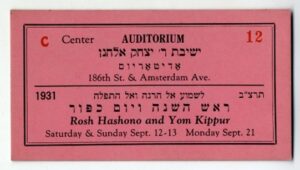Sep 13, 2023 By: sberger
 Rosh HaShanah Ticket, 1931
Rosh HaShanah Ticket, 1931Yeshiva University Archives
One of Yeshiva University’s 2022 graduation day events featured Ribo in concert; “the audience was visibly moved by the poignant music, responding to Ribo’s distinct ability to distill the poetry and holiness of Judaism into song,” as described by a University press release, replete with photos of the event.
Music has the power to transport words beyond the intellect and infuse them with emotion, a key to opening hearts and souls in prayer. The shofar blasts on Rosh Hashanah are wordless cries, visceral primordial forces which evoke fear and trembling. Imagine a High Holy service punctuated by the call of the shofar in the Nathan Lamport auditorium in Yeshiva’s Main Building (now Zysman Hall), an awe-inspiring space for prayer during the Days of Awe. Rosh HaShanah Ticket, 1931
Rosh HaShanah Ticket, 1931Yeshiva University Archives
 High Holiday Services Poster, 1945
High Holiday Services Poster, 1945Yeshiva University Archives
 High Holiday flyer, 1951
High Holiday flyer, 1951Yeshiva University Archives
Public Relations Events, Box 229, YU Synagogue Council
 High Holiday flyer, 1951
High Holiday flyer, 1951Yeshiva University Archives
Public Relations Events, Box 229, YU Synagogue Council
 Rosh HaShanah greeting card issued by Yeshiva University in the 1960s
Rosh HaShanah greeting card issued by Yeshiva University in the 1960sYeshiva University Archives
